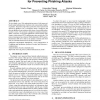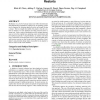96 search results - page 8 / 20 » Protecting browser state from web privacy attacks |
WWW
2007
ACM
14 years 8 months ago
2007
ACM
We show that the time web sites take to respond to HTTP requests can leak private information, using two different types of attacks. The first, direct timing, directly measures re...
WWW
2009
ACM
14 years 8 months ago
2009
ACM
We developed a new Web authentication protocol with passwordbased mutual authentication which prevents various kinds of phishing attacks. This protocol provides a protection of us...
JCP
2006
13 years 7 months ago
2006
As the ubiquitous society spreads rapidly, various private information circulates in large quantities. Information increases explosively in recent years, the importance of privacy ...
CCS
2008
ACM
13 years 9 months ago
2008
ACM
BootJacker is a proof-of-concept attack tool which demonstrates that authentication mechanisms employed by an operating system can be bypassed by obtaining physical access and sim...
PERCOM
2011
ACM
12 years 11 months ago
2011
ACM
Abstract—Online social networks such as Facebook, MySpace, and Orkut store large amounts of sensitive user data. While a user can legitimately assume that a social network provid...


